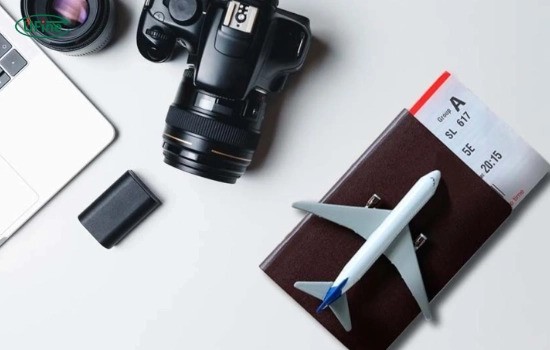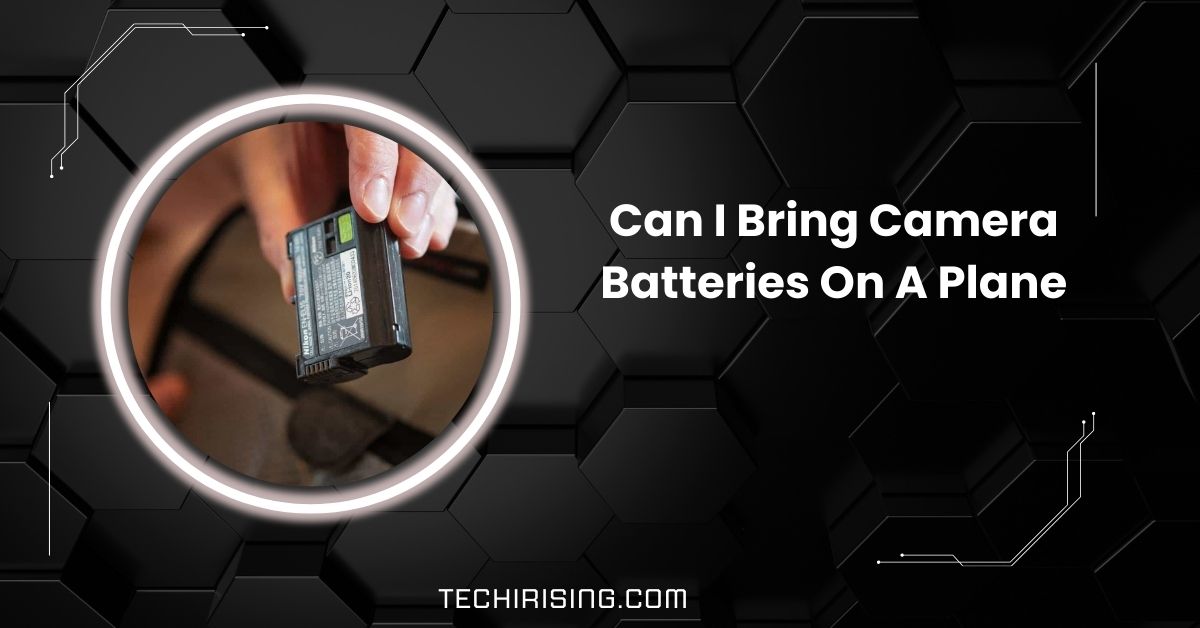Traveling with camera batteries can be confusing, especially with all the rules and safety concerns surrounding air travel.
Yes, you can bring camera batteries on a plane. Always pack lithium-ion batteries as carry-on, limit spares to two, and never place them in checked luggage for safety reasons.
This guide simplifies everything you need about traveling with camera batteries so you can focus on enjoying your journey and taking amazing photos.
Understanding Battery Types and Airline Regulations
Airlines categorize batteries based on their chemical composition and capacity, measured in watt-hours (Wh) for lithium-based batteries or grams of lithium content for lithium-metal batteries. The most common types include:
- Alkaline Batteries (AA, AAA, C, D): These standard dry cell batteries are generally allowed in carry-on and checked luggage without quantity limitations. However, they must be protected from damage and short-circuiting.
- Lithium-Ion Batteries: Commonly used in cameras and other electronic devices, these batteries are subject to specific regulations due to potential safety risks.
What Are Camera Batteries Made Of?

Camera batteries are made from different materials, depending on their type. Common options include lithium-ion, used in most modern cameras because it is lightweight and rechargeable, and lithium-metal, found in non-rechargeable batteries for some devices.
Older nickel-metal hydride (NiMH) batteries are rechargeable but less efficient. Standard alkaline batteries like AA or AAA are often used for camera accessories.
Knowing your battery type helps you understand airline rules and how to pack them for your travels safely.
Airline Policies on Camera Batteries
Each airline has its rules, but most follow guidelines from the FAA, ICAO, or other aviation bodies. Key considerations include:
- Battery capacity limits (in watt-hours).
- The number of spare batteries permitted.
- Storage recommendations during flights.
Regulations For Lithium-Ion Camera Batteries
Lithium-ion batteries have specific rules for air travel. If your battery is under 100 watt-hours (Wh), you can carry it in both checked and carry-on luggage, but carrying it in your hand luggage is safer.
Batteries between 101 Wh and 160 Wh need airline approval and are limited to two spares. Batteries over 160 Wh are not allowed in passenger planes. Always check your battery’s watt-hour rating and airline’s policies before traveling to avoid problems.
Also Read: How Long Does Dash Cam Footage Last: A Complete Guide!
Packing And Safety Tips
Packing camera batteries safely is important to avoid risks. Always carry spare batteries in your hand luggage, as they’re not allowed in checked baggage.
Use original packaging or a protective case to prevent short circuits. Cover the battery terminals with tape or store them in individual plastic bags.
For installed batteries, ensure your device can’t accidentally turn on during the flight. Damaged batteries shouldn’t be packed at all. Follow these tips to travel smoothly with your batteries.
Airline And International Variations

Airlines and countries may have slightly different rules for camera batteries. Most follow FAA or ICAO guidelines, but some have stricter limits on the number or type of batteries allowed.
European and U.S. airlines generally have similar policies, while some Asian airlines may require extra approvals.
Always check your airline’s website and any international regulations before flying, especially if you have layovers. Knowing the rules for your destination ensures your journey is hassle-free.
Recent Safety Concerns
Lithium-ion batteries can pose safety risks, especially if damaged or packed improperly. Overheating can cause fires, known as thermal runaway.
Airlines have seen an increase in battery-related incidents, leading to stricter rules. Spare batteries in checked luggage are a major concern because cargo holds aren’t monitored during flights.
Always carry spares in your hand luggage to avoid accidents and check batteries for damage. Being cautious protects you, your belongings, and everyone on the plane.
Why Are There Restrictions On Camera Batteries?
Restrictions on camera batteries exist because lithium-ion batteries can overheat, which might cause fires during a flight.
This is called thermal runaway. Airplanes are pressurized, increasing this risk, especially in cargo areas where fires are harder to manage.
To keep everyone safe, airlines have set strict rules for carrying, storing, and packing these batteries. Following these rules helps avoid accidents and ensures a safe journey for passengers, crew, and belongings.
Can You Bring Camera Batteries In Checked Luggage?
You can bring camera batteries in checked luggage, but only if installed on your device. Spare lithium-ion batteries are not allowed in checked bags because they pose a fire risk.
Instead, you should pack spare batteries in your carry-on luggage where any issues can be quickly addressed.
Always pack batteries safely, with terminals covered and no damage visible, to ensure they travel safely with you.
Must Read: How Much Data Does Blink Camera Use – Here’s The Truth!
What Are The Rules For International Flights?
International flights follow similar rules for camera batteries, but there can be some differences. Most airlines allow batteries under 100 watt-hours without issues.
However, batteries over 101 watt-hours may need approval, and limits can vary by country or airline. Some Asian airlines have stricter rules, while European and U.S. airlines are more consistent.
Before flying, check your airline’s policies and any additional rules for your destination or layovers to avoid surprises.
What Happens During Security Checks?

During security checks, you might need to remove your camera batteries from your bag for inspection. Security officers may ask you to separate spare batteries, show their watt-hour ratings, or unpack them if they’re not stored properly.
Devices with installed batteries might need to be turned on for proof of function. Always pack your batteries safely and follow instructions to avoid delays. Being prepared helps make the process quick and stress-free for you and the security staff.
What Are The Risks Of Lithium-Ion Batteries?
Lithium-ion batteries can overheat and cause fires, especially if damaged or packed incorrectly. This overheating, known as thermal runaway, can happen when batteries are short-circuited or exposed to extreme conditions.
Fires in an airplane, particularly in the cargo area, are hard to control and pose serious risks. That’s why airlines have strict rules for packing and carrying lithium-ion batteries. Proper handling reduces these risks and helps ensure a safe flight for everyone.
What To Do If Your Battery Is Damaged?
If your battery is damaged—like swollen, leaking, or cracked—you shouldn’t bring it on a plane. Damaged batteries are unsafe and can cause fires.
Replace the battery before your trip, or leave it at home. Airlines won’t allow damaged batteries on board for safety reasons.
Always check your batteries for visible signs of wear and tear before packing. If you’re unsure, avoiding traveling with the battery is better to ensure everyone’s safety.
Can I Bring Camera Batteries on a Plane International
Yes, you can bring camera batteries on international flights, but rules may vary by airline and country. Batteries under 100 watt-hours are usually allowed in carry-on luggage. Check your airline’s policies and regulations for your destination to ensure a smooth experience.
Read Out: Does Freymiller Have Driver-Facing Cameras – Ultimate Guide!
Can I Bring Camera Batteries on a Plane Checked
You can bring camera batteries installed in devices in checked luggage. However, spare lithium-ion batteries are prohibited in checked bags due to fire risks. Always pack spares in your carry-on for safety and compliance with airline rules.
Are Canon Camera Batteries Allowed on Planes
Yes, Canon camera batteries are allowed on planes if they meet airline regulations. Most Canon batteries are under 100 watt-hours, making them safe for carry-on luggage. Pack them properly to avoid short circuits or damage during travel.
Can You Bring AA Batteries on a Plane
Yes, AA batteries are allowed in both carry-on and checked luggage. These are considered safe for travel. Pack them securely to prevent short circuits, and avoid carrying damaged or leaking batteries.
How to Carry Camera Batteries on Airplane
Carry spare camera batteries in your carry-on luggage. Use original packaging or protective cases and cover terminals to prevent short circuits. For installed batteries, ensure the device cannot turn on during the flight. Always check for airline-specific rules.
How Many Camera Batteries Can I Take on a Plane

For batteries under 100 watt-hours, there’s usually no strict limit, but they must be in carry-on luggage. For larger batteries (101-160 watt-hours), most airlines allow up to two spares with prior approval. Check with your airline for exact limits.
Can I Bring 10000mAh Power Bank on Plane?
Yes, a 10,000mAh power bank (approximately 37 watt-hours) is allowed in your carry-on luggage. It must not exceed airline watt-hour limits, typically 100 watt-hours. Avoid packing power banks in checked luggage to comply with safety regulations.
FAQs
1. How Do You Travel with a Camera Battery?
Carry camera batteries in your hand luggage. Use protective cases, cover terminals, and follow airline rules to avoid problems.
2. Can I Bring My Canon Camera on a Plane?
Yes, you can bring your Canon camera on a plane. Keep it in your carry-on for easy access during security checks.
3. Does TSA Allow Batteries in Checked Luggage?
TSA allows installed batteries in checked luggage. Spare lithium-ion batteries must be in carry-on luggage for safety reasons.
4. Are Batteries Allowed in Carry-On or Checked?
Spare batteries are only allowed in carry-on luggage. Installed batteries can be in either carry-on or checked luggage.
5. Do I Need to Take My Camera Out at Airport Security?
Yes, you might need to remove your camera during security checks. Follow TSA or airline instructions to ensure smooth screening.
6. Where Do You Put Batteries When Flying?
Place spare batteries in your carry-on luggage. Keep them in protective cases to prevent damage or short circuits during the flight.
7. Can I Fly with a Dewalt 20V Battery?
Yes, you can fly with a Dewalt 20V battery. Keep it in your carry-on, ensuring it meets airline watt-hour limits.
8. Can You Fly with AAA Batteries?
Yes, AAA batteries are allowed in both carry-on and checked luggage. Pack them securely to avoid damage during your flight.
Conclusion
In conclusion, traveling with camera batteries requires careful planning and attention to airline rules. You can ensure a smooth journey by understanding the different types of batteries, their specific regulations, and safety precautions. Always pack lithium-ion batteries in your carry-on luggage, check the watt-hour limits, and avoid bringing damaged batteries. Whether flying domestically or internationally, staying informed about airline policies will help you travel confidently with your camera gear. Following these simple guidelines keeps your devices safe and helps prevent any travel disruptions. Safe travels and happy photographing!





